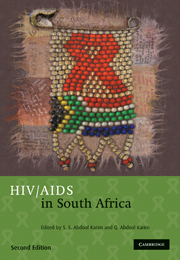Book contents
- Frontmatter
- Contents
- List of Contributors
- Foreword: Peter Piot
- Foreword: Nelson R Mandela
- Acknowledgements
- Section 1 Birth of a rapidly growing epidemic
- Section 2 The virus, the human host and their interactions
- Section 3 HIV risk factors and prevention strategiess
- 9 Reducing sexual risk behaviours: theory and research, successes and challenges
- 10 Barrier methods
- 11 Mother-to-child transmission (MTCT) of HIV-1
- 12 Sexually transmitted infections
- 13 Safe blood supplies
- 14 Intravenous drug use in South Africa
- 15 Positive prevention interventions
- 16 New prevention strategies under development and investigation
- Section 4 Focal groups for understanding the HIV epidemic
- Section 5 The impact of AIDS
- Section 6 Treating HIV
- Section 7 What does the future hold?
- Index
11 - Mother-to-child transmission (MTCT) of HIV-1
Published online by Cambridge University Press: 07 September 2011
- Frontmatter
- Contents
- List of Contributors
- Foreword: Peter Piot
- Foreword: Nelson R Mandela
- Acknowledgements
- Section 1 Birth of a rapidly growing epidemic
- Section 2 The virus, the human host and their interactions
- Section 3 HIV risk factors and prevention strategiess
- 9 Reducing sexual risk behaviours: theory and research, successes and challenges
- 10 Barrier methods
- 11 Mother-to-child transmission (MTCT) of HIV-1
- 12 Sexually transmitted infections
- 13 Safe blood supplies
- 14 Intravenous drug use in South Africa
- 15 Positive prevention interventions
- 16 New prevention strategies under development and investigation
- Section 4 Focal groups for understanding the HIV epidemic
- Section 5 The impact of AIDS
- Section 6 Treating HIV
- Section 7 What does the future hold?
- Index
Summary
MOST CHILDREN WITH HIV infection have contracted their disease through mother-to-child transmission (MTCT) although about 5% may have been infected through the use of unsterile injections or similar exposures in poorly managed health facilities. MTCT occurs in utero, during labour and delivery and during breastfeeding. The overall transmission rates without preventive measures being taken (such as use of antiretrovirals, caesarean section and safe delivery) are between 25% and 45% of all children born to HIV positive women in Africa. The wide use of preventative interventions has markedly decreased MTCT in the industrialised countries and in many developing countries. HIV/AIDS is a significant contributor to infant mortality and deaths in children under the age of five years in Africa. Indeed these two rates are important indicators of infant and child health in general. Under-five year mortality rates in the latter part of the last century due to implementation of programmes aimed at improving child survival; however these gains are being steadily eroded because of the HIV/AIDS epidemic in the most affected countries, most of which are in southern Africa.
Among the factors that predispose to transmission, maternal viral load and blood cd4 counts have a direct effect on transmission. Obstetrical factors such as vaginal or caesarian delivery, premature rupture of membranes and interventions during delivery contribute to hiv transmission. Infant factors such as prematurity and mucosal lesions are also risk factors increasing the rates of transmission.
- Type
- Chapter
- Information
- HIV/AIDS in South Africa , pp. 201 - 215Publisher: Cambridge University PressPrint publication year: 2010
- 1
- Cited by

